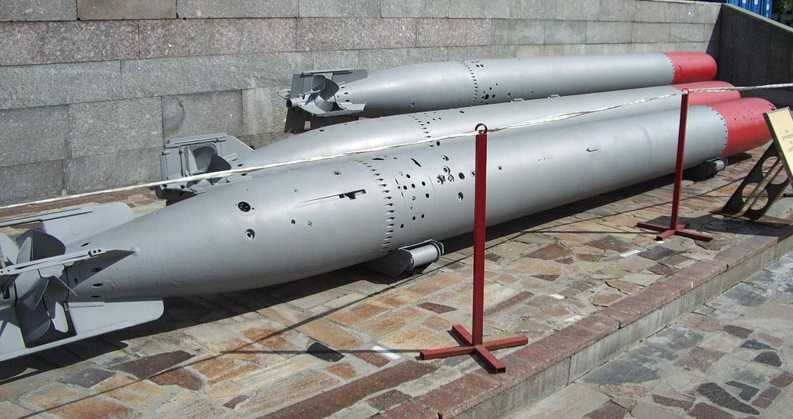Prior to the end of World War I, Russian torpedoes were designated by their caliber in inches and pattern year. For example 18" Pattern 1912 was a 18" (45 cm) torpedo accepted into service in 1912.
During the Soviet era torpedoes were designated in two different ways. Basic torpedoes were designated by caliber in centimeters followed by a dash and the last two digits of the year they were accepted into service with letters added to denote modifications. For example, the 53-38U was a 53.3 cm (21") torpedo accepted into service in 1938, with the "U" meaning improved. Other codes after the number were:
| M | "Mederniziravannaya" | Modernized |
|---|---|---|
| N | "Novik" | Designed for Novik class DDs |
| PM | "Pribor Manevrirovaniya" | Torpedo able to maneuver |
| A | "Aviatsionnaya" | Aircraft |
| AV | "Aviatsionnaya Vysotnaya" | Aircraft High Altitude |
| VT | "Vysonaya Torpeda" | High Altitude Torpedo |
| NT | "Nizkaya Torpeda" | Low Altitude Torpedo |
Torpedoes intended for special applications were designated with a code first and then the pattern number. The pattern numbers were usually consecutive, but sometimes denoted the pattern year or were a random number. For example, the ET-80 was an Electrical Torpedo Pattern Year 1980. Some of the codes for these torpedoes were:
| TAV | "Torpeda Aviatsionnaya Vysotnaya" | Torpedo, Aircraft, High Altitude |
|---|---|---|
| TAN | "Torpeda Aviatsionnaya Nizkaya" | Torpedo, Aircraft, Low Altitude |
| ET | "Elektricheskaya Torpeda" | Electrical Torpedo |
| SET | "Samonavodyaschayasya Elektricheskaya Torpeda" | Guided Electrical Torpedo |
| SAET | "Samonavodyaschayasya Akustcheskaya | Elektricheskaya Torpeda" - Guided Acoustic Electrical Torpedo |
| AT | "Aviatsionnaya Topreda" | Aircraft Torpedo |
| RAT | "Reaktivanaya Aviatsionnaya Topreda" | Rocket Propelled Aircraft Torpedo |
| APR | "Aviacionnaia Podvodnaia Raketa" | Airborne Underwater Rocket |
| VTT | "Vertoletnaia Teleupravliaemaia Torpeda" | Helicopter Launched wire-guided torpedo |
Most of the Russian torpedoes manufactured before 1918 were made at the Obukhov and Lessner factory in St. Petersburg and in the Nikolaev factory in the South of Russia. In 1918 those factories closed due to the Russian Civil War and only Lessner reopened in 1927 under the new name Dvigatel'. In 1932 the Nauchno-Issledovatel'skii Minno-Torpednyi Institut (Mine-Torpedo Development Institute) was created in order to facilitate torpedo development.
By the end of the 1930s torpedoes were being built at four factories: The Dvigatel' and Voroshilov factories at Leningrad, "Krasny Progress" factory in Dnepropetrovsk and the Dagdiesel' factory near Makhachkala. During World War II all of these factories were in the area occupied or blockaded by the Germans. Both of the Leningrad factories were evacuated to Ural'sk in 1941, while the Dnepropetrovsk factory was evacuated first to the Dagdiesel' factory. Later, both of these factories were evacuated to Alma-Ata in Kazahkstan. After the war the Leningrad factories were returned to their previous locations and have remained the premier Russian/Soviet torpedo manufacturers to the present day.
Russian Navy used the Whitehead type torpedoes and their derivatives, which were propelled using compressed air.
Russian Navy used the Whitehead type torpedoes and their derivatives, which were propelled using compressed air.
Most of the Russian and Soviet torpedoes of this period were wet-heaters, using heated compressed air and piston propulsion. In 1939 the first successful electrical torpedo was designed and in 1943 it went into service.
In 1936 an experimental torpedo using nitric acid and turpentine for propulsion was made and it showed a phenomenal speed and range, achieving 11-12 km at 45 knots. However, nitric acid proved to be too corrosive to be of practical use and this torpedo was not accepted into service. In 1939 a turbine-powered torpedo was designed, but the advent of the war halted its development.
Post-war torpedoes have been mainly electric or Oxygen or Hydrogen-Peroxide piston engined.
World War I and World War II torpedoes used TNT as a warhead explosive.
Most of the Soviet torpedoes during World War II used a simple contact fuze, which was reportedly reliable.
The first magnetic fuze was designed in 1932, but this was extremely unreliable and it was not accepted into service.
In 1941 a new magnetic fuze was designed and tested. This proved to be reliable and it was accepted into service in 1942. During the war a total of 243 torpedoes with these magnetic fuzes were fired and there were no reported problems.
Data from:
- "Torpedoes of VMF SSSR" by Yu.L. Korshunov and A.A. Strokov
Special help from Vladimir Yakubov.
05 August 2016 - Benchmark
23 April 2021 - Updated to HTML 5 format





